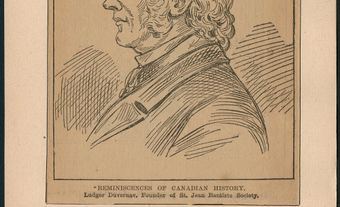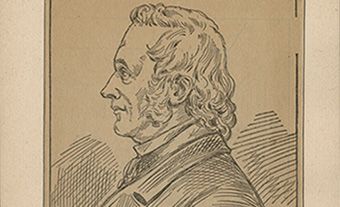This article was originally published in Maclean’s magazine on February 28, 2000. Partner content is not updated.
It was an empire built upon scratchy radio stations, weekly newspapers and the hardscrabble mentality of Northern Ontario in the midst of the Great Depression. Founder Roy Thomson was like nothing Canada had ever produced.Thomson Sells His Newspapers
It was an empire built upon scratchy radio stations, weekly newspapers and the hardscrabble mentality of Northern Ontario in the midst of the Great Depression. Founder Roy Thomson was like nothing Canada had ever produced. A bulky, bullet-headed man of immense determination, he fairly leapt from one media conquest to the next, lapping up community newspapers and private television licences with the famous view that he was being granted "a licence to print money." On his death in 1976, the Thomson empire passed to son Ken, a grown man in his 50s who was still known as "young Ken," a most unlikely media mogul.
A tall, gentle man as eccentrically shy as his father was bluntly flamboyant, Ken Thomson nonetheless continued the train of media acquisitions. At its peak at the end of the 1980s, the Thomson empire owned about 70 newspapers in Britain and about 180 in the United States and Canada, including its flagship, the Toronto-based Globe and Mail. Other media barons - Rupert Murdoch, Conrad Black, Ted Turner - bask in the international limelight. But in net worth - nearly $21 billion, making him the richest man in Canada and one of the wealthiest in the world - 76-year-old Ken Thomson dwarfs them all.
And his rapidly taken decision last week to sell the remaining 54 dailies - save for the Globe - and more than 75 community newspapers shows he is determined to stay ahead of the pack. Like his father before him, Thomson has bounded from one shiny media bauble to the next as fast as technology changes, and his newspaper sell-off is designed to move the empire that bears his name - 73.3 per cent of it his - even more solidly into the world of electronic information and Internet delivery. Over 40 per cent of Thomson Corp.'s more than $9 billion in annual revenue now comes from online ventures. Within five years, the company wants that flow to reach 80 per cent. The target is the especially lucrative market of financial information users, lawyers and health-care professionals - eschewing the mass market and the power of the press in favour of selling data to the high-end buyer.
Almost as remarkable as the change in direction is the speed with which it was carried out. The decision to sell the newspaper division at the core of the company's identity was made over a period of a very few months. Thomson Corp. chief executive officer Richard Harrington began an "end of century" analysis of the company's direction last September. In December, it went to the board of directors and again in January. Two weeks later, there was the decision to sell and move on. "No matter how you cut it, this is a pretty bold move," observes Roy Megarry, a retired publisher of the Globe and a consultant to Thomson. "Very few companies overcome their culture and emotions. Their past usually drags them down."
As for Ken Thomson, a noted sentimentalist when it comes to pampering small dogs and acquiring 19th-century paintings, he has shown a remarkable ability to stay that emotion in business dealings. A reclusive man, he declined all interviews when the announcement was made and even turned down the option of a family-authored op-ed piece in the Globe. Caught off guard by a reporter for the rival National Post who tracked him down at home, Thomson allowed he was feeling "a little bit sentimental" about the sale, but that "business is business ... The world changes, situations change, corporations change, we change personally. We've just got to be prepared to accept it."
The end of an era? Surely, but not the end of a corporate empire, or even of newspapers. Harrington says he expects to earn at least $3.75 billion from the sale of the papers, all located in North America, and may even see some bidding wars, especially in the United States. The five Canadian dailies on the block are the Winnipeg Free Press, the Brandon Sun, The Lethbridge Herald, the Medicine Hat News and the Thunder Bay Chronicle-Journal. And the three largest Canadian newspaper groups - Black's Hollinger Inc., which controls 61 dailies led by the National Post; Quebecor Inc., with 16, including the Sun tabloids; and Torstar Corp., with five southern Ontario dailies anchored by the mammoth Toronto Star - have all expressed interest.
In Parliament, Prime Minister Jean Chrétien mused that the House of Commons industry committee might want to examine the proposed sale for concentration of ownership reasons. All five Canadian papers are the dominant ones in their local markets and bring in annual revenue of about $150 million. The NDP has charged that if Black's Hollinger chain snaps up these papers, it would lead to an expansion of his conservative editorial views and perhaps even bitter labour disputes like the current one at the Calgary Herald.
Hollinger is among the media companies that are trying to leverage the reputations of their local newspapers into an Internet presence. But Thomson's Internet play is of an entirely different magnitude. The company controls some of the biggest legal, health and online learning databases in North America and Europe. The seeds for the current evolution were sown back in the 1980s, not long after Thomson purchased the Globe and a batch of Canadian dailies. At that point, Thomson consisted of two companies - a British and North American division, each of which controlled newspapers and other investments. When these were pulled together in 1989, the information publishing group - where Harrington started - became the driving force. Over the years, investments were shed in North Sea oil (in 1989), in the family's holdings in the Hudson's Bay Co. retail stores (in 1997) and more recently in the once lucrative leisure travel industry. "I've always seen us as an information publishing company with special interests in newspapers, travel and other areas," Harrington says. "You will see us make more strategic acquisitions in the global e-information and solutions business."
Thomson's newspapers bring in only 16 per cent of its current revenues, and many have had the reputation of being small-market monopoly operations where every pencil stub is counted before a new one is issued. The Kent commission on newspaper ownership in 1981 called them a "lacklustre aggregation of cashboxes." Still, they are nothing to sneer at. The chain is the ninth-largest in the United States on the basis of circulation and, excluding the Globe, last year enjoyed earnings of $330 million on revenues of $1.2 billion. In a rare compliment from a rival, Hollinger president David Radler noted that Thomson was a pioneer in managing newspapers as a chain. Thomson was also the first to pump serious money into the Globe, when previous owners refused, to help it become a national paper with satellite printing plants across the country. And the company was an innovator in organizing its American holdings into regional clusters five years ago to serve regional advertisers.
Some observers have queried Thomson's intention to keep the Globe as its sole newspapering enterprise, suggesting the daily might be sacrificed in the intense war with the National Post. But Harrington is adamant that the Globe was never on the list to be sold. He says it is one of the few papers in North America with the database and the brand-name reputation to transcend the limitations of print in the years ahead. To ex-publisher Megarry, "the Thomson family has always had a great affection for the Globe. Ken's father had wanted to buy the Globe and then Ken felt he got it for his dad. And now a new reason for maintaining it has emerged - e-commerce."
But in Thomson's world, sentimentality can only be stretched so far. In Timmins, where father Roy got his start, some of the old-timers still fondly remember young Ken from his stint as a reporter in 1947, says Syl Belisle, publisher of the now Hollinger-controlled Timmins Daily Press. Thomson returned in 1984 to donate the old press building as a historic site to the city of Timmins. It later fell into disrepair and was demolished. But The Daily Press is thriving since the Thomsons sold it in 1996, Belisle says. "We're bigger now. We're up to 16 pages minimum. We've added more staff, new products. We're even putting out a phone book." There is still life after the Thomsons move on.
'A Licence to Print Money'
Information is power. And the beauty of specialized electronic databases is that while they are costly to assemble, they are cheap to maintain. Moreover, the same data can be sold over and over again. Through a series of acquisitions and expansions, Thomson Corp. has built up a broad array of electronic and publishing services for lawyers, doctors, teachers and many other professions. So unless it's a powerful brand like The Globe and Mail, who needs newspapers?
1999 nine-month revenues by market group:
Legal 36%
Financial 21%
Science and health 16%
Newspapers 16%
Learning 11%
Source: Thomson Corp.
Maclean's February 28, 2000

 Share on Facebook
Share on Facebook Share on X
Share on X Share by Email
Share by Email Share on Google Classroom
Share on Google Classroom


